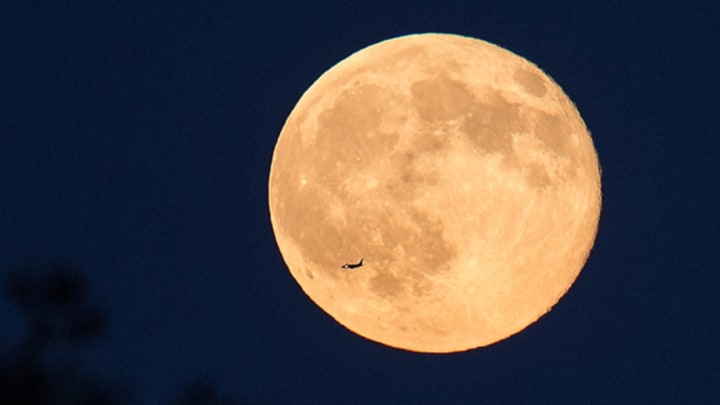Have you heard about the supermoon tonight? Have you heard that it’s going to be big? Huge! Terrifying! The last time a full moon appeared this large, they say, the astronaut corps consisted of a single monkey named Albert, who would soon be shot into space on a V2 rocket. (Things did not end well for Albert, nor for his successor, Albert II.) It hasn’t seemed this big since 1948! What celestial chaos can we expect?
Take a deep breath. Technically, the supermoon’s peak will occur tomorrow morning, November 14, at 8:52 a.m. EST. But we think you should go out tonight (and maybe tomorrow night too). It’s going to be a pretty big full moon, and yes, it will likely be the biggest you’ve ever seen (and will not see again until November 25, 2034), but “biggest” is a relative term. If you didn’t already know that this supermoon would be juicing, you probably wouldn’t have really noticed. So what’s going on up there?
OUR MOON IS WEIRD
Relative to the Earth, the Moon is really big. Only gas giants Saturn and Jupiter possess larger moons, though it seems more through attrition than anything else. They’re working with overwhelmingly superior planetary sizes and moon totals, in comparison to our pale blue dot. Jupiter’s diameter is 11 times that of the Earth; Saturn’s diameter, 9.5 times. The two colossal planets have in their orbits a total of 129 known moons—and yet all but four of them are smaller than the lone Moon of our little world (our newly discovered mini-moon–like asteroid excluded).
If our moon is unique, its orbit is even wackier. Some might call it downright weird. The Moon's orbit is really far from Earth, and the tilt of its orbit is large to the point of being inexplicable. Scientists are pretty certain that a massive collision between the Earth and another planet sent debris into space that would eventually coalesce to form the Moon. Existing models for this, however, have never adequately been able to account for the moon’s large tilt.
One recent hypothesis for the Moon’s odd behavior states that the “Big Whack” changed our axial tilt by as much as 80 degrees and sent us spinning incredibly fast. That initial high tilt―the Earth might once have spun on its side―would explain how we managed eventually to slow back down. According to the same model, the Moon’s orbit of the Earth on the outset was 15 times closer than it is today, and that as it migrated away from the Earth, the Sun began to exert influence on its orbit. The whack, the tilt, the speed, the Sun―taken together, they offer a compelling explanation for the Moon’s odd orbital tilt today.
ENJOY TONIGHT’S MOON FOR ITS OWN SAKE
Because the Moon’s orbit is elliptical, when it is closest to the Earth in a revolution―a.k.a. at perigee―it appears larger; when it is at apogee, or farthest away, it appears smaller. Perigee and apogee are not identical from orbit to orbit. The Earth and the Moon both fall under the gravitational influence of the Sun.
When perigee coincides with a full moon, you get what is colloquially called a “supermoon.” (Not an astronomy term.) The full moon in November is called the Beaver Moon. (Also not an astronomy term.) Long ago, this was considered the time to set your beaver traps so that you would have enough pelts to make winterwear. Because tonight’s perigee brings the surfaces of the Earth and the moon a scant 216,486 miles apart, the supermoon will appear up to 14 percent bigger. But unless you’re a devoted Moon watcher, you might have a hard time spotting that. The moon will also be 30 percent brighter, NASA says, because of the Earth’s proximity in its orbit from the Sun. In all, it’s going to be a gorgeous super beaver moon, but it won’t change your life. Set your expectations accordingly.
So hope for clear skies, go outside―maybe even dust off the telescope, uncork a bottle of wine, and make an evening of it―and enjoy the Moon for the same reason you enjoy the constellations, meteor showers, the movement of the planets, and the appearance of the International Space Station. (If it's cloudy, check out the livestream from Slooh.) Because space isn’t somewhere out there. Earth is as much “in space” as any other object in the universe. We are part of space. And to peer into the night sky is to look simultaneously at the distant past of the universe, and the near future of humankind.
